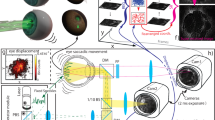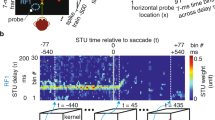Abstract
WHEN the retinal image of the visual field is suddenly displaced by a saccadic eye movement, perceptual sensitivity to a weak test flash at the time of displacement is reduced. Flashes presented from 40 ms before until at least 100 ms after the displacement may be affected. I have discovered1 that visibility is similarly reduced when the visual field is displaced as a whole before a stationary (fixating) eye. This throws doubt on the idea that either oculomotor activity2 or mechanical acceleration of the eyeball3 is required to account for such effects. It suggests rather that the surge of neural activity caused by the rapid displacement of the retinal image has side-effects that interfere with processing of the signals generated by the test flash, and so raise the perceptual threshold1.
This is a preview of subscription content, access via your institution
Access options
Subscribe to this journal
Receive 51 print issues and online access
$199.00 per year
only $3.90 per issue
Buy this article
- Purchase on SpringerLink
- Instant access to full article PDF
Prices may be subject to local taxes which are calculated during checkout
Similar content being viewed by others
References
MacKay, D. M., Nature, 225, 90 (1970).
Holt, E. B., Harvard Psychol. Studies, 1, 3 (1903).
Richards, W., J. Opt. Soc. Amer., 58, 1559A (1968).
Author information
Authors and Affiliations
Rights and permissions
About this article
Cite this article
MACKAY, D. Interocular Transfer of Suppressive Effects of Retinal Image Displacement. Nature 225, 872–873 (1970). https://doi.org/10.1038/225872a0
Received:
Issue date:
DOI: https://doi.org/10.1038/225872a0
This article is cited by
-
Visual stability with goal-directed eye and arm movements toward a target displaced during saccadic suppression
Psychological Research (1995)
-
Mislocation of Test Flashes during Saccadic Image Displacements
Nature (1970)



